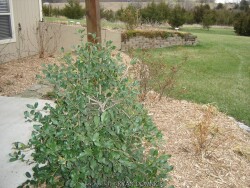

***Shrub descriptions available with future update!***American Tree Holly, is also known as Ilex opaca
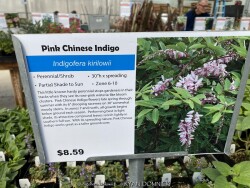

***Description for this plant available with future update!*** Indigofera kirilowii is also known as Chinese Indigo.
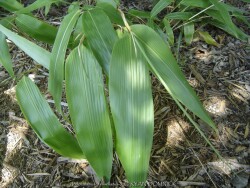

***Description for this bamboo available with future update!***Largeleaf Groundcover Bamboo / Indocalamus, is also known as Indocalamus tessellatus
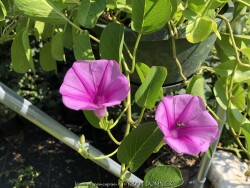

Beach Morning Glory / Railroad Vine (Ipomoea pes-caprae) is the most rapidly growing annual in out library capable of growing 30-50' in one summer! (100-200' in native coastal dune habitats) It can fill a large annual planting bed with bright green foliage after 1 month when planted in May and taking advantage of early summer rains, heat and humidity. It is also great cascading down retaining walls or large pots! Deep root system will grow in pure sand or typical garden soil provided that regular moisture is available. In Eastern Kansas, typically our 40 inches of rainfall is sufficient without extra water in good soils. The magenta flowers are 2-3" across and absolutely beautiful and will get noticed; blooms sporadically in early summer but covered by late summer and early fall in Kansas. Who would have thought that a coastal sand dune stabilization plant would thrive or even grow at all in Kansas? It has been trialed here as a hanging basket plant, cascading wall plant, and mass groundcover in annual beds. If growing as a potted plant and trying to overwinter, it is very difficult as these plants do not like low humidity or low light; best to replace each year.
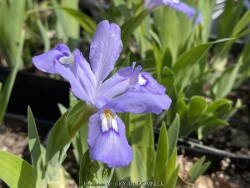

***Description for this perennial available with future update!*** Iris cristata is also known as Dwarf Crested Iris.
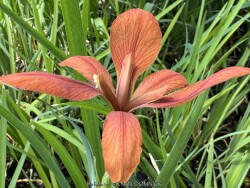

***Description for this perennial available with future update!*** Iris fulva is also known as Copper Iris / Native Red Flag Iris >>>>>This plant can also be used as a marginal aquatic plant growing in shallow water. It can also grow as a bog plant needing constantly moist soil rich in organic matter. As a rain garden plant, it will thrive is a depressed area in the landscape that collects rain water from a roof during spring and summer periods of rain but then go dormant if the water hole dries out completely.
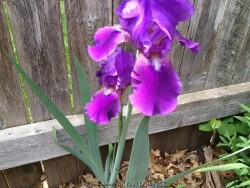

***Description for this perennial available with future update!*** Iris germanica is also known as Bearded Iris (Mixed Colors).
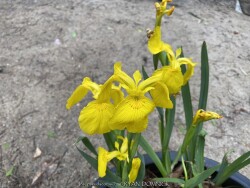

***Description for this perennial available with future update!*** Iris pseudacorus is also known as Yellow Flag Water Iris >>>>>This plant is normally used as a marginal aquatic plant growing in shallow water. It can also grow as a bog plant needing constantly moist soil rich in organic matter. As a rain garden plant, it will thrive is a depressed area in the landscape that collects rain water from a roof during spring and summer periods of rain but then go dormant if the water hole dries out completely.
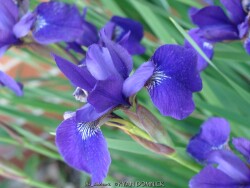

***Description for this perennial available with future update!*** Iris sibirica 'Caesar's Brother' is also known as Caesar's Brother Siberian Iris>>>>>This plant can also be used as a marginal aquatic plant growing in shallow water. It can also grow as a bog plant needing constantly moist soil rich in organic matter. As a rain garden plant, it will thrive is a depressed area in the landscape that collects rain water from a roof during spring and summer periods of rain but then go dormant if the water hole dries out completely.
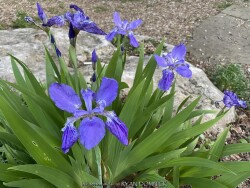

Japanese Roof Iris (Iris tectorum) is a rhizomatous perennial iris species with attractive clusters of wide fan-like foliage. It is native of China and Korea, with lavender-blue, bluish-violet, purple-blue, blue-lilac or sky blue flowers. Although flowers are attractive, this plant is grown just as much for its foliage. It prefers to grow in rich, well-drained, forest soil in part shade. This plant will grow in thin soils on top of rock outcroppings provided that moisture is available; Iris tectorum is commonly called 'roof iris' because it was grown in the thatch of Chinese and Japanese houses. Mostly used in Kansas gardens as an accent or curiosity plant.
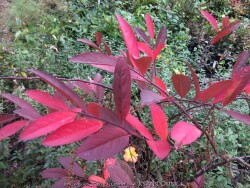

Virginia sweetspire (Itea virginica) is a native shrub found along creeks and streams in the eastern United States. Foliage consists of a simple leaf, medium to light green, and usually glossy. White cascading flowers cover the plants in spring for about a month with pollinators flocking to the occasion. Fall color is outstanding shades of red and purple. Leaves cling to the stem and are very persistent down to about 10-15°F often finally dropping in December. Stems during the winter take on an attractive reddish-brown and green coloring. Sweetspire is truly a four-season shrub! In the landscape, combine with native plants, hardy tropicals, or summer flowering plants. These plants can tolerate saturated soils and are perfect for rain gardens or any other rich soil garden areas. North exposures are fine in zone 6 but not any further north as winter kill becomes a problem in zone 5. Water is usually the limiting factor in southern climates zone 7-9. Sweetspire is highly sensitive to iron chlorosis so avoid alkaline soils. In our eastern Kansas climate, we avoid afternoon sun and dry soils. Full shade is tolerated but not dry shade. Fall color will be reduced or nonexistent in full shade. Morning sun is best for avoiding leaf burn but still allowing fall coloring. Overall, this is a great garden plant when sited in the right conditions. Itea virginica 'Henry's Garnet' has larger flowers and better fall color compared to the species.
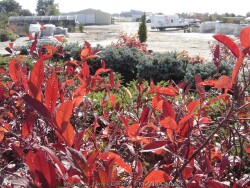

Virginia sweetspire (Itea virginica) is a native shrub found along creeks and streams in the eastern United States. Foliage consists of a simple leaf, medium to light green, and usually glossy. White cascading flowers cover the plants in spring for about a month with pollinators flocking to the occasion. Fall color is outstanding shades of red and purple. Leaves cling to the stem and are very persistent down to about 10-15°F often finally dropping in December. Stems during the winter take on an attractive reddish-brown and green coloring. Sweetspire is truly a four-season shrub! In the landscape, combine with native plants, hardy tropicals, or summer flowering plants. These plants can tolerate saturated soils and are perfect for rain gardens or any other rich soil garden areas. North exposures are fine in zone 6 but not any further north as winter kill becomes a problem in zone 5. Water is usually the limiting factor in southern climates zone 7-9. Sweetspire is highly sensitive to iron chlorosis so avoid alkaline soils. In our eastern Kansas climate, we avoid afternoon sun and dry soils. Full shade is tolerated but not dry shade. Fall color will be reduced or nonexistent in full shade. Morning sun is best for avoiding leaf burn but still allowing fall coloring. Overall, this is a great garden plant when sited in the right conditions. Itea virginica 'Merlot' features more mounded, compact stature and more persistant burgundy fall color making it an improvement over older varieties such as the old favorite 'Henry's Garnet'. Flowers are scented!
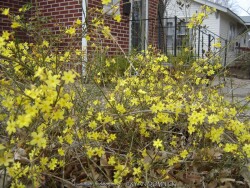

Winter Jasmine (Jasminium nudiflorum) is a spreading dwarf shrub native to China. It features dark green glossy leaves that remain attractive all summer. The density of the shrub overtime is unmatched, completely eliminating any weeds including tree seedlings from emerging. Bright yellow five-petaled flowers resembling forsythia bloom extremely early in the spring usually in February or March before foliage growth (in Lawrence, KS). Flower buds are hardy to about 0° so flowering may not occur every year if temperatures get lower. Occasionally this shrub will bloom in the middle of winter when we have a 2-3 week warm spell. When it does bloom, it creates a spectacular show completely covering the shrub. It will grow in full sun or full shade in medium to dry soils including some dry-shade. It tolerates moist soils and brief periods of saturated soils after heavy rains. Fall color is yellow but drops quickly. Stems take on an olive greenish color in winter rendering them mildly attractive. Winter jasmine is commonly grown as a spreading groundcover shrub for difficult areas, frequently used as large mass planting on hills. Because of its tolerance for adverse conditions including poor soil and rock, it is often one of the last resort plants that will survive in certain areas. It competes well under large shade trees and helps absorb leaf litter allowing it to break down and add nutrients back to the soil. This plant also does well in hot dry parking lot islands, hell strips, and along busy roads in full sun. Another great spot is planting on top of a retaining wall allowing it to cascade down. Further uses include erosion control and streambank stabilization. We do not recommend planting in small areas or in spaces that it will overrun neighboring plants. It only spreads above ground as horizontally growing stems touch the ground and root. This does make maintenance easier to control the spread of the plant versus digging out rhizomes. Avoid North exposures and wet soils. Considered one of the most versatile and best plants for solving difficult landscape challenges.
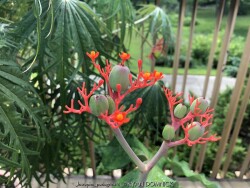

The foliage and red flowers of Jatropha make excellent specimen plants. Usually used as a patio or house plant in Kansas, they can also be grown as an annual. Grow in full sun to part sun with optional extra watering including that which comes from rainfall. Plants with time to acclimate will thrive in full sun but be careful not to rush it or sunburning will occur. Generally if moving outside for the summer, allow 2-3 weeks of part shade or morning sun before placing in full sun. Repotting may or may not be needed depending on how large you want the plant to grow. Protect from temperatures below 45 degrees F and move into a bright window over the winter with no watering. Do not allow Jatropha to freeze or get close to freezing especially if soil is wet or death will occur. As a winter house plant, it will look presentable all winter long with monthly waterings and bright light. As a permanent house plant, provide bright light and allow the soil to dry between waterings for a few years of enjoyment.
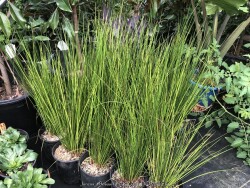

***Description for this grass available with future update!*** Juncus effusus is also known as Bog Rush / Juncus >>>>>This plant can also be used as a marginal aquatic plant growing in shallow water. It can also grow as a bog plant needing constantly moist soil rich in organic matter. As a rain garden plant, it will thrive is a depressed area in the landscape that collects rain water from a roof during spring and summer periods of rain but then go dormant if the water hole dries out completely.
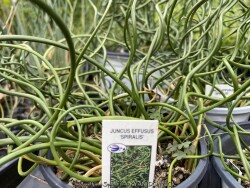

***Description for this plant available with future update!*** Juncus effusus 'Spiralis' is also known as Corkscrew Rush>>>>>> This plant can also be used as a marginal aquatic plant growing in shallow water. It can also grow as a bog plant needing constantly moist soil rich in organic matter. As a rain garden plant, it will thrive is a depressed area in the landscape that collects rain water from a roof during spring and summer periods of rain but then go dormant if the water hole dries out completely.
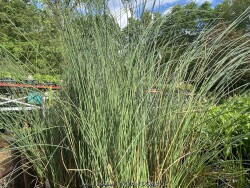

***Description for this grass available with future update!*** Juncus inflexus is also known as Blue Rush / Juncus >>>>>This plant can also be used as a marginal aquatic plant growing in shallow water. It can also grow as a bog plant needing constantly moist soil rich in organic matter. As a rain garden plant, it will thrive is a depressed area in the landscape that collects rain water from a roof during spring and summer periods of rain but then go dormant if the water hole dries out completely.
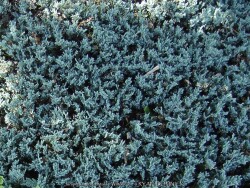

***Shrub descriptions available with future update!*** Juniperus horizontalis 'Wiltoni' is also known as Blue Rug Juniper.
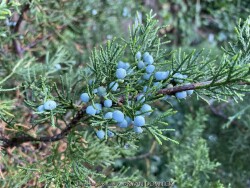

***Tree descriptions available with future update!***Eastern Red Ceder, is also known as Juniperus virginiana
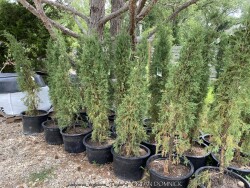

***Tree descriptions available with future update!*** Juniperus virginiana 'Taylor' is also known as Taylor Narrow Eastern Red Ceder
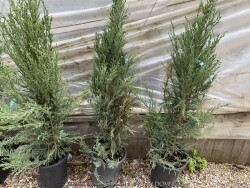

***Tree descriptions available with future update!*** Juniperus virginiana / scopulorum 'Skyrocket' is also known as Skyrocket Juniper
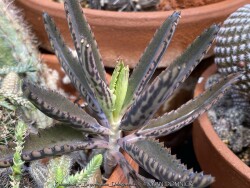

Mother of Millions (Kalanchoe delagoensis) is a very unusual succulent (and sometimes weed) grown for its beautiful symmetrical foliage with neatly aligned babies(offspring) growing along the leaf edges. Tall orange flowers emerge from larger mature pot grown plants. Usually used as a patio or house plant in Kansas, they can also be grown as an annual. Grow in full sun to part sun with optional extra watering including that which comes from rainfall. Plants with time to acclimate will thrive in full sun but be careful not to rush it or sunburning will occur. Generally if moving outside for the summer, allow 2-3 weeks of part shade or morning sun before placing in full sun. Repotting may or may not be needed depending on how large you want the plant to grow; plants can continue to grow and tolerate extremely root-bound pots. Protect from temperatures below 35 degrees F and move into a bright window over the winter with no watering. Do not allow Mother of Millions grown in pots to freeze solid or get close to freezing especially if soil is wet or death may occur. As a winter house plant, it will look presentable all winter long with just a few monthly or no waterings if you forget. As a permanent house plant, provide bright light and allow the soil to dry between waterings for many years of carefree enjoyment. Note that Mother of Millions is called so because "babies" constantly fall off the mother plant and can become weeds in your other succulent plants. This is mostly interesting (especially for kids) to see how some plants can propagate. Undesired plants can easily be pulled out and given to a new home.
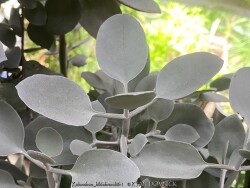

The silver foliage color of (Kalanchoe hildebrandtii) steals the show. Usually used as a patio or house plant in Kansas, they can also be grown as an annual if purchased in bulk. Grow in full sun to part sun with optional extra watering including that which comes from rainfall. Plants with time to acclimate will thrive in full sun but be careful not to rush it or sunburning will occur. Generally if moving outside for the summer, allow 2-3 weeks of part shade or morning sun before placing in full sun. Repotting may or may not be needed depending on how large you want the plant to grow; plants can continue to grow and tolerate extremely root-bound pots. Protect from temperatures below 35 degrees F and move into a bright window over the winter with no watering. Do not allow Silver Teaspoons plant grown in pots to freeze solid or get close to freezing especially if soil is wet or death may occur. As a winter house plant, it will look presentable all winter long with just a few monthly or almost no waterings if you forget. As a permanent house plant, provide bright light and allow the soil to dry between waterings for many years of carefree enjoyment. Potted plants are very low maintenance and tolerant of indoor environments. This is not at all a big-box store plant so be prepared to expand your plant palette with Silver Teaspoons!
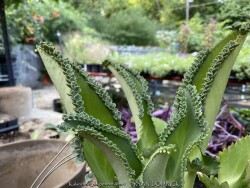

Mother of Thousands (Kalanchoe daigremontiana) is a very unusual succulent (and sometimes a weed) grown for its beautiful symmetrical foliage with neatly aligned babies (offspring) growing along the leaf edges. Tall orange flowers emerge from larger mature pot grown plants. Usually used as a patio or house plant in Kansas, they can also be grown as an annual. Grow in full sun to part sun with optional extra watering including that which comes from rainfall. Plants with time to acclimate will thrive in full sun but be careful not to rush it or sunburning will occur. Generally if moving outside for the summer, allow 2-3 weeks of part shade or morning sun before placing in full sun. Repotting may or may not be needed depending on how large you want the plant to grow; plants can continue to grow and tolerate extremely root-bound pots. Protect from temperatures below 35 degrees F and move into a bright window over the winter with no watering. Do not allow Mother of Thousands grown in pots to freeze solid or get close to freezing especially if soil is wet or death may occur. As a winter house plant, it will look presentable all winter long with just a few monthly or no waterings if you forget. As a permanent house plant, provide bright light and allow the soil to dry between waterings for many years of carefree enjoyment. Note that Mother of Thousands is called so because "babies" constantly fall off the mother plant and can become weeds in your other succulent plants. This is mostly interesting (especially for kids) to see how some plants can propagate. Undesired plants can easily be pulled out and given to a new home.


The foliage color, texture and patterns make Paddle Plant (Kalanchoe luciae) an excellent architectural specimen. Usually used as a patio or house plant in Kansas, they can also be grown as an annual. Grow in full sun to part sun with optional extra watering including that which comes from rainfall. Plants with time to acclimate will thrive in full sun but be careful not to rush it or sunburning will occur. Generally if moving outside for the summer, allow 2-3 weeks of part shade or morning sun before placing in full sun. Repotting may or may not be needed depending on how large you want the plant to grow; plants can continue to grow and tolerate extremely root-bound pots. Protect from temperatures below 35 degrees F and move into a bright window over the winter with no watering. Do not allow Paddle plant grown in pots to freeze solid or get close to freezing especially if soil is wet or death may occur. As a winter house plant, it will look presentable all winter long with just a few monthly or no waterings if you forget. As a permanent house plant, provide bright light and allow the soil to dry between waterings for many years of carefree enjoyment. Potted plants are very low maintenance needing only old leaves trimmed once per year. This is not at all a big-box store plant so be prepared to expand your plant palette with Paddle plant!


***Description for this perennial available with future update!*** Kniphofia 'Orange Blaze' is also known as Orange Blaze Red Hot Poker Plant.
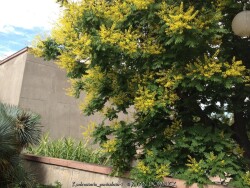

***Tree descriptions available with future update!*** Koelreuteria paniculata is also known as Goldenrain Tree
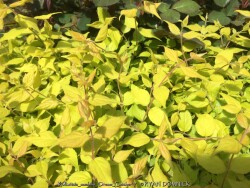

***Shrub descriptions available with future update!***Dream Catcher Beautybush, is also known as Kolkwitzia amabilis 'Dream Catcher'
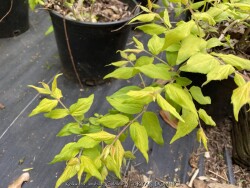

***Shrub descriptions available with future update!***Goldleaf/Golden Beauty Beautybush, is also known as Kolkwitzia amabilis 'Goldleaf'


***Shrub descriptions available with future update!***Dream Catcher Beautybush, is also known as Kolkwitzia amabilis 'Dream Catcher'
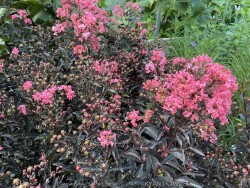

Crapemyrtle (Lagerstroemia) is a beautiful summer flowering shrub that dies down to the ground as a perennial each year in Zone 6 Kansas. Flower colors include bright red, pink, magenta, purple, and white. Many cultivars have been released improving foliage color, disease resistance, and flower blooming length. Newer cultivars now have maroon or reddish foliage adding interest before blooming. Beautiful fall color is often overlooked; shades of red, orange, and purple develop when Night temperatures reach into the 40s. In Kansas, crape myrtles grow best with hot south or west exposures or on south facing berms or hillsides. But they are suitable in any garden location as long as they are in full sun, they will build enough energy to come back from complete winter top-kill each year. Generally are 40 inches of rain per year is sufficient without extra watering, but if drought conditions occur, flowering will be reduced or shortened. Brief periods of excessive water and saturated soils are tolerated adding to their versatility. Many people from the south associate Crapemyrtles as a tree. That is true that in Texas and much of the Southeast, beautiful tree forms with exfoliating bark will occur because of mild winters. In Oklahoma and Arkansas for example crapemyrtles are usually grown as large shrubs experiencing major winterkill every 5-10 years. In Kansas and Missouri, or where temperatures regularly get to 0°, all top growth will die back and they will be grown as a woody perennial. After flowering and beautiful fall color is dropped, many people leave crapemyrtles throughout the winter to enjoy the winter interest of the dried seed heads. By March or April, cut plants close to the ground and watch for new growth. Flowering occurs on new wood and is much larger and more dramatic on sprouts from the ground. Flowers are often twice as big when grown this way. In the past, only fast-growing tree size cultivars for appropriate and Kansas because they have the ability to recover the fastest from complete winterkill and grow into a flowering-sized shrub by July. Now there are dwarf cultivars that are wood-hardy to -10 zone 6 for those not wanting to worry about winterkill. No disease or pest problems. Crapemyrtle are awesome for pollinators in the late season garden and especially effective when combined with vitex, butterfly bush, and/or caryopteris. Lagerstroemia 'Center Stage Coral' is a new Proven Winners® release. This 3-5' shrub features deep black foliage and pink flowers with yellow stamens; it truly will command center stage in your landscape. Note that this cultivar is wood hardy down to zone 6b. All Proven Winners® plants are legally propagated, healthy and vigorous, true to name, and tagged with color pictures and growing information.
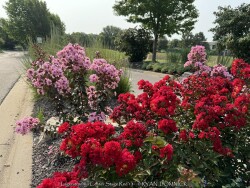

Crapemyrtle (Lagerstroemia) is a beautiful summer flowering shrub that dies down to the ground as a perennial each year in Zone 6 Kansas. Flower colors include bright red, pink, magenta, purple, and white. Many cultivars have been released improving foliage color, disease resistance, and flower blooming length. Newer cultivars now have maroon or reddish foliage adding interest before blooming. Beautiful fall color is often overlooked; shades of red, orange, and purple develop when Night temperatures reach into the 40s. In Kansas, crape myrtles grow best with hot south or west exposures or on south facing berms or hillsides. But they are suitable in any garden location as long as they are in full sun, they will build enough energy to come back from complete winter top-kill each year. Generally are 40 inches of rain per year is sufficient without extra watering, but if drought conditions occur, flowering will be reduced or shortened. Brief periods of excessive water and saturated soils are tolerated adding to their versatility. Many people from the south associate Crapemyrtles as a tree. That is true that in Texas and much of the Southeast, beautiful tree forms with exfoliating bark will occur because of mild winters. In Oklahoma and Arkansas for example crapemyrtles are usually grown as large shrubs experiencing major winterkill every 5-10 years. In Kansas and Missouri, or where temperatures regularly get to 0°, all top growth will die back and they will be grown as a woody perennial. After flowering and beautiful fall color is dropped, many people leave crapemyrtles throughout the winter to enjoy the winter interest of the dried seed heads. By March or April, cut plants close to the ground and watch for new growth. Flowering occurs on new wood and is much larger and more dramatic on sprouts from the ground. Flowers are often twice as big when grown this way. In the past, only fast-growing tree size cultivars for appropriate and Kansas because they have the ability to recover the fastest from complete winterkill and grow into a flowering-sized shrub by July. Now there are dwarf cultivars that are wood-hardy to -10 zone 6 for those not wanting to worry about winterkill. No disease or pest problems. Crapemyrtle are awesome for pollinators in the late season garden and especially effective when combined with vitex, butterfly bush, and/or caryopteris. Lagerstroemia 'Center Stage Red' is a new Proven Winners® release. This 3-5' shrub features deep black foliage and glowing red flowers; it truly will command center stage in your landscape. Note that this cultivar is wood hardy down to zone 6b. All Proven Winners® plants are legally propagated, healthy and vigorous, true to name, and tagged with color pictures and growing information.
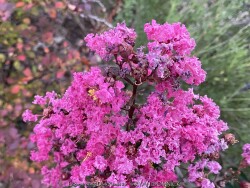

Crapemyrtle (Lagerstroemia) is a beautiful summer flowering shrub that dies down to the ground as a perennial each year in Zone 6 Kansas. Flower colors include bright red, pink, magenta, purple, and white. Many cultivars have been released improving foliage color, disease resistance, and flower blooming length. Newer cultivars now have maroon or reddish foliage adding interest before blooming. Beautiful fall color is often overlooked; shades of red, orange, and purple develop when Night temperatures reach into the 40s. In Kansas, crape myrtles grow best with hot south or west exposures or on south facing berms or hillsides. But they are suitable in any garden location as long as they are in full sun, they will build enough energy to come back from complete winter top-kill each year. Generally are 40 inches of rain per year is sufficient without extra watering, but if drought conditions occur, flowering will be reduced or shortened. Brief periods of excessive water and saturated soils are tolerated adding to their versatility. Many people from the south associate Crapemyrtles as a tree. That is true that in Texas and much of the Southeast, beautiful tree forms with exfoliating bark will occur because of mild winters. In Oklahoma and Arkansas for example crapemyrtles are usually grown as large shrubs experiencing major winterkill every 5-10 years. In Kansas and Missouri, or where temperatures regularly get to 0°F, all top growth will die back and they will be grown as a woody perennial. After flowering and beautiful fall color is dropped, many people leave crapemyrtles throughout the winter to enjoy the winter interest of the dried seed heads. By March or April, cut plants close to the ground and watch for new growth. Flowering occurs on new wood and is much larger and more dramatic on sprouts from the ground. Flowers are often twice as big when grown this way. In the past, only fast-growing tree size cultivars for appropriate and Kansas because they have the ability to recover the fastest from complete winterkill and grow into a flowering-sized shrub by July. Now there are dwarf cultivars that are wood-hardy to -10 zone 6 for those not wanting to worry about winterkill. No disease or pest problems. Crapemyrtle are awesome for pollinators in the late season garden and especially effective when combined with vitex, butterfly bush, and/or caryopteris. Lagerstroemia 'Dark Roast' is a Walters Gardens, Inc. selection and part of its BARISTA® Collection. It features dark foliage with leaves having red undertones, especially near the tips of the stems. In late summer to early fall, bright fuchsia pink flowers are produced over the fully rounded, compact habit. This is a dwarf selection growing 18-30" tall and wood hardy to about zone 6b. (estimated)
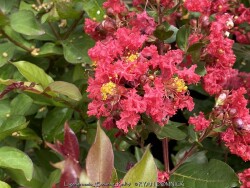

Crapemyrtle (Lagerstroemia) is a beautiful summer flowering shrub that dies down to the ground as a perennial each year in Zone 6 Kansas. Flower colors include bright red, pink, magenta, purple, and white. Many cultivars have been released improving foliage color, disease resistance, and flower blooming length. Newer cultivars now have maroon or reddish foliage adding interest before blooming. Beautiful fall color is often overlooked; shades of red, orange, and purple develop when Night temperatures reach into the 40s. In Kansas, crape myrtles grow best with hot south or west exposures or on south facing berms or hillsides. But they are suitable in any garden location as long as they are in full sun, they will build enough energy to come back from complete winter top-kill each year. Generally are 40 inches of rain per year is sufficient without extra watering, but if drought conditions occur, flowering will be reduced or shortened. Brief periods of excessive water and saturated soils are tolerated adding to their versatility. Many people from the south associate Crapemyrtles as a tree. That is true that in Texas and much of the Southeast, beautiful tree forms with exfoliating bark will occur because of mild winters. In Oklahoma and Arkansas for example crapemyrtles are usually grown as large shrubs experiencing major winterkill every 5-10 years. In Kansas and Missouri, or where temperatures regularly get to 0°, all top growth will die back and they will be grown as a woody perennial. After flowering and beautiful fall color is dropped, many people leave crapemyrtles throughout the winter to enjoy the winter interest of the dried seed heads. By March or April, cut plants close to the ground and watch for new growth. Flowering occurs on new wood and is much larger and more dramatic on sprouts from the ground. Flowers are often twice as big when grown this way. In the past, only fast-growing tree size cultivars for appropriate and Kansas because they have the ability to recover the fastest from complete winterkill and grow into a flowering-sized shrub by July. Now there are dwarf cultivars that are wood-hardy to -10 zone 6 for those not wanting to worry about winterkill. No disease or pest problems. Crapemyrtle are awesome for pollinators in the late season garden and especially effective when combined with vitex, butterfly bush, and/or caryopteris. Enduringtm Red Crapemyrtle (Lagerstroemia 'PIILAG B5') features clusters of bright true scarlet-red blooms appear all summer against the glossy green foliage. Leaves emerge red and turn to dark green. This mid-size variety grows 4 to 5 feet tall and wide with a tight growth habit. Developed by Greenleaf Nursery Company as part of the Garden Debut® Collection.
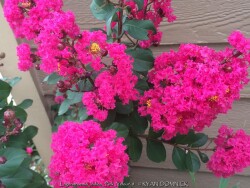

Crapemyrtle (Lagerstroemia) is a beautiful summer flowering shrub that dies down to the ground as a perennial each year in Zone 6 Kansas. Flower colors include bright red, pink, magenta, purple, and white. Many cultivars have been released improving foliage color, disease resistance, and flower blooming length. Newer cultivars now have maroon or reddish foliage adding interest before blooming. Beautiful fall color is often overlooked; shades of red, orange, and purple develop when Night temperatures reach into the 40s. In Kansas, crape myrtles grow best with hot south or west exposures or on south facing berms or hillsides. But they are suitable in any garden location as long as they are in full sun, they will build enough energy to come back from complete winter top-kill each year. Generally are 40 inches of rain per year is sufficient without extra watering, but if drought conditions occur, flowering will be reduced or shortened. Brief periods of excessive water and saturated soils are tolerated adding to their versatility. Many people from the south associate Crapemyrtles as a tree. That is true that in Texas and much of the Southeast, beautiful tree forms with exfoliating bark will occur because of mild winters. In Oklahoma and Arkansas for example crapemyrtles are usually grown as large shrubs experiencing major winterkill every 5-10 years. In Kansas and Missouri, or where temperatures regularly get to 0°, all top growth will die back and they will be grown as a woody perennial. After flowering and beautiful fall color is dropped, many people leave crapemyrtles throughout the winter to enjoy the winter interest of the dried seed heads. By March or April, cut plants close to the ground and watch for new growth. Flowering occurs on new wood and is much larger and more dramatic on sprouts from the ground. Flowers are often twice as big when grown this way. In the past, only fast-growing tree size cultivars for appropriate and Kansas because they have the ability to recover the fastest from complete winterkill and grow into a flowering-sized shrub by July. Now there are dwarf cultivars that are wood-hardy to -10 zone 6 for those not wanting to worry about winterkill. No disease or pest problems. Crapemyrtle are awesome for pollinators in the late season garden and especially effective when combined with vitex, butterfly bush, and/or caryopteris. Lagerstroemia indica 'Pink Velour', developed by Dr. Carl Whitcomb, has deep pink long-lasting flowers. Deep wine red leaves emerge in spring and age to dark purplish green creating quite a contrast with bright flowers.
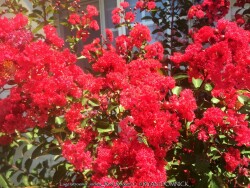

Crapemyrtle (Lagerstroemia) is a beautiful summer flowering shrub that dies down to the ground as a perennial each year in Zone 6 Kansas. Flower colors include bright red, pink, magenta, purple, and white. Many cultivars have been released improving foliage color, disease resistance, and flower blooming length. Newer cultivars now have maroon or reddish foliage adding interest before blooming. Beautiful fall color is often overlooked; shades of red, orange, and purple develop when Night temperatures reach into the 40s. In Kansas, crape myrtles grow best with hot south or west exposures or on south facing berms or hillsides. But they are suitable in any garden location as long as they are in full sun, they will build enough energy to come back from complete winter top-kill each year. Generally are 40 inches of rain per year is sufficient without extra watering, but if drought conditions occur, flowering will be reduced or shortened. Brief periods of excessive water and saturated soils are tolerated adding to their versatility. Many people from the south associate Crapemyrtles as a tree. That is true that in Texas and much of the Southeast, beautiful tree forms with exfoliating bark will occur because of mild winters. In Oklahoma and Arkansas for example crapemyrtles are usually grown as large shrubs experiencing major winterkill every 5-10 years. In Kansas and Missouri, or where temperatures regularly get to 0°, all top growth will die back and they will be grown as a woody perennial. After flowering and beautiful fall color is dropped, many people leave crapemyrtles throughout the winter to enjoy the winter interest of the dried seed heads. By March or April, cut plants close to the ground and watch for new growth. Flowering occurs on new wood and is much larger and more dramatic on sprouts from the ground. Flowers are often twice as big when grown this way. In the past, only fast-growing tree size cultivars for appropriate and Kansas because they have the ability to recover the fastest from complete winterkill and grow into a flowering-sized shrub by July. Now there are dwarf cultivars that are wood-hardy to -10 zone 6 for those not wanting to worry about winterkill. No disease or pest problems. Crapemyrtle are awesome for pollinators in the late season garden and especially effective when combined with vitex, butterfly bush, and/or caryopteris. Lagerstroemia indica 'Red Rocket', developed by Dr. Carl Whitcomb, features brilliant cherry-red flowers with dark green foliage. It is one of the fastest growing crape myrtles reaching 4-6' in one season when cut to the ground in Kansas.
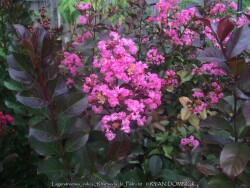

Crapemyrtle (Lagerstroemia) is a beautiful summer flowering shrub that dies down to the ground as a perennial each year in Zone 6 Kansas. Flower colors include bright red, pink, magenta, purple, and white. Many cultivars have been released improving foliage color, disease resistance, and flower blooming length. Newer cultivars now have maroon or reddish foliage adding interest before blooming. Beautiful fall color is often overlooked; shades of red, orange, and purple develop when Night temperatures reach into the 40s. In Kansas, crape myrtles grow best with hot south or west exposures or on south facing berms or hillsides. But they are suitable in any garden location as long as they are in full sun, they will build enough energy to come back from complete winter top-kill each year. Generally are 40 inches of rain per year is sufficient without extra watering, but if drought conditions occur, flowering will be reduced or shortened. Brief periods of excessive water and saturated soils are tolerated adding to their versatility. Many people from the south associate Crapemyrtles as a tree. That is true that in Texas and much of the Southeast, beautiful tree forms with exfoliating bark will occur because of mild winters. In Oklahoma and Arkansas for example crapemyrtles are usually grown as large shrubs experiencing major winterkill every 5-10 years. In Kansas and Missouri, or where temperatures regularly get to 0°, all top growth will die back and they will be grown as a woody perennial. After flowering and beautiful fall color is dropped, many people leave crapemyrtles throughout the winter to enjoy the winter interest of the dried seed heads. By March or April, cut plants close to the ground and watch for new growth. Flowering occurs on new wood and is much larger and more dramatic on sprouts from the ground. Flowers are often twice as big when grown this way. In the past, only fast-growing tree size cultivars for appropriate and Kansas because they have the ability to recover the fastest from complete winterkill and grow into a flowering-sized shrub by July. Now there are dwarf cultivars that are wood-hardy to -10 zone 6 for those not wanting to worry about winterkill. No disease or pest problems. Crapemyrtle are awesome for pollinators in the late season garden and especially effective when combined with vitex, butterfly bush, and/or caryopteris. Lagerstroemia indica 'Rhapsody in Pink' was developed by Dr. Carl Whitcomb. This upright growing shrub features light pink summer flowers appearing against handsome foliage, which emerges a purple hue that persists most of the season.
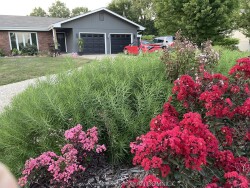

Crapemyrtle (Lagerstroemia) is a beautiful summer flowering shrub that dies down to the ground as a perennial each year in Zone 6 Kansas. Flower colors include bright red, pink, magenta, purple, and white. Many cultivars have been released improving foliage color, disease resistance, and flower blooming length. Newer cultivars now have maroon or reddish foliage adding interest before blooming. Beautiful fall color is often overlooked; shades of red, orange, and purple develop when Night temperatures reach into the 40s. In Kansas, crape myrtles grow best with hot south or west exposures or on south facing berms or hillsides. But they are suitable in any garden location as long as they are in full sun, they will build enough energy to come back from complete winter top-kill each year. Generally are 40 inches of rain per year is sufficient without extra watering, but if drought conditions occur, flowering will be reduced or shortened. Brief periods of excessive water and saturated soils are tolerated adding to their versatility. Many people from the south associate Crapemyrtles as a tree. That is true that in Texas and much of the Southeast, beautiful tree forms with exfoliating bark will occur because of mild winters. In Oklahoma and Arkansas for example crapemyrtles are usually grown as large shrubs experiencing major winterkill every 5-10 years. In Kansas and Missouri, or where temperatures regularly get to 0°, all top growth will die back and they will be grown as a woody perennial. After flowering and beautiful fall color is dropped, many people leave crapemyrtles throughout the winter to enjoy the winter interest of the dried seed heads. By March or April, cut plants close to the ground and watch for new growth. Flowering occurs on new wood and is much larger and more dramatic on sprouts from the ground. Flowers are often twice as big when grown this way. In the past, only fast-growing tree size cultivars for appropriate and Kansas because they have the ability to recover the fastest from complete winterkill and grow into a flowering-sized shrub by July. Now there are dwarf cultivars that are wood-hardy to -10 zone 6 for those not wanting to worry about winterkill. No disease or pest problems. Crapemyrtle are awesome for pollinators in the late season garden and especially effective when combined with vitex, butterfly bush, and/or caryopteris.
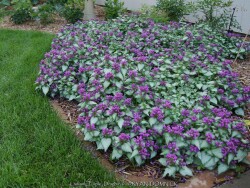

***Description for this perennial available with future update!*** Lamium 'Purple Dragon' is also known as Purple Dragon Lamium / Deadnettle >>>>>Ultra cold-hardy plants from northern climates normally dislike our long hot humid summers; although we are on the Southern edge of this plants adaptability, it still survives reasonably well here. Look for a cold microclimate planting location such as East or North exposure.>>>>>
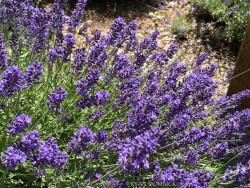

Lavender (Lavandula angustifolia 'Munstead') is one of the most well-known flowers and herbal qualities. It features grayish green aromatic and evergreen foliage with lavender flowers. Blooming usually starts during the heat of summer and continues until frost. Lavender is native to Mediterranean climates with average moisture in the summer and dry, mild winters. Because of its heritage, it resents cold wet winters and needs well drained sandy, silty, or rocky soil. In the short term, it will typically grow in any soil during the summer making it very useful even as an annual. In Kansas landscapes, it is commonly used as an annual or short-lived perennial where lots of color is needed in full sun. Root rot is likely when placed in poor draining soil or even in rich garden soil. Summer heat is usually not a problem but not extreme heat of a south or west wall. Lavender does reasonably well growing out of retaining walls or on top of retaining walls with perfect drainage. Lavender is actually a woody shrub but grown like a in perennial because every so often do you need to trim it back to a few inches off the ground. Lavender combines nicely with any red, orange, or yellow flower or where needing a perennial with evergreen winter color. Lavandula angustifolia 'Munstead' is a commonly sold cultivar.
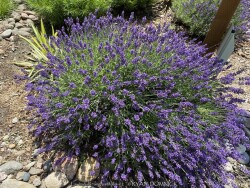

Lavender is one of the most well-known flowers and herbal qualities. It features grayish green aromatic and evergreen foliage with lavender flowers. Blooming usually starts during the heat of summer and continues until frost. Lavender is native to Mediterranean climates with average moisture in the summer and dry, mild winters. Because of its heritage, it resents cold wet winters and needs well drained sandy, silty, or rocky soil. In the short term, it will typically grow in any soil during the summer making it very useful even as an annual. In Kansas landscapes, it is commonly used as an annual or short-lived perennial where lots of color is needed in full sun. Root rot is likely when placed in poor draining soil or even in rich garden soil. Summer heat is usually not a problem but not extreme heat of a south or west wall. Lavender does reasonably well growing out of retaining walls or on top of retaining walls with perfect drainage. Lavender is actually a woody shrub but grown like a in perennial because every so often do you need to trim it back to a few inches off the ground. Lavender combines nicely with any red, orange, or yellow flower or where needing a perennial with evergreen winter color. Lavandula angustifolia 'Munstead' is a commonly sold cultivar.
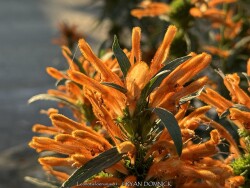

***Description for this perennial available with future update!*** Leonotis loenurus is also known as Lions Tail / Wild Dagga / Orange Lions Ear >>>>> must be kept very dry in winter when growing in climates with cold, wet winters.Testing cold hardiness in Lawrence, KS....will update in the future.
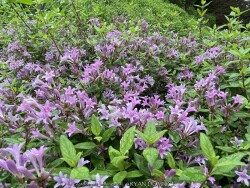

***Shrub descriptions available with future update!***Purple Flowering Leptodermis, is also known as Leptodermis oblonga


***Shrub descriptions available with future update!***Gibraltar Bush Clover, is also known as Lespedeza thunbergii 'Gibraltar'
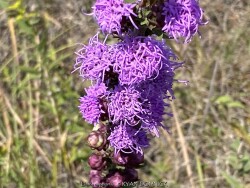

***Description for this perennial available with future update!*** Liatris aspera is also known as Rough Blazing Star / Liatris >>>>> >>>>> Blooms later (late summer to fall) than most other Liatris species. This species is distinguished from other Liatris species by its rough appearance and rounded individual flower clusters. Good winter drainage is important.
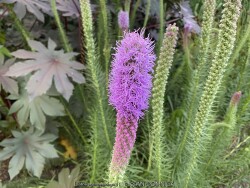

***Description for this perennial available with future update!***Prairie Blazing Star / Liatris, is also known as Liatris pycnostachya


***Description for this perennial available with future update!***Stargazer Garden Lily, is also known as Lilium 'Stargazer'
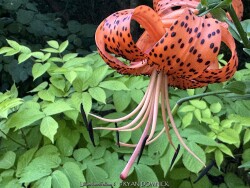

***Description for this perennial available with future update!*** Lilium lancifolium is also known as Tiger Lily.
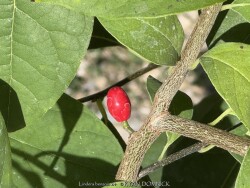

Native Spicebush (Lindera benzoin) is a multi-stemmed, irregularly rounded understory shrub native to eastern North America, including Eastern Kansas. Foliage is a matte bright green then turning an attractive yellow in autumn. The yellow flowers grow in showy clusters appearing in early spring before foliage emerges. Flowers on male and female plants look noticeably different. The flowers have sepals in place of petals and a very sweet aroma. Red berries are produced if a male and female plant are close together. Nutritious fruit is quickly eaten by several bird species. Full shade to part shade is best with average to moisture-retentive rich soils. Height reaches 6-9' tall in Kansas and Missouri. The name "Spicebush" comes from foliage and stems that are aromatic when bruised. Spicebush tolerates alkalinity, and in the wild is sometimes found in soils with exposed limestone. Some drought is tolerated if planted in shade; dry-shade experiments are in progress in Lawrence, KS. Use in the landscape as a wildlife friendly background shrub or grouping in shade gardens.
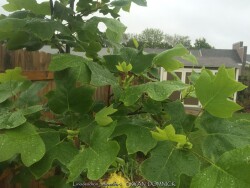

***Tree descriptions available with future update!***Tuliptree, is also known as Liriodendron tulipifera